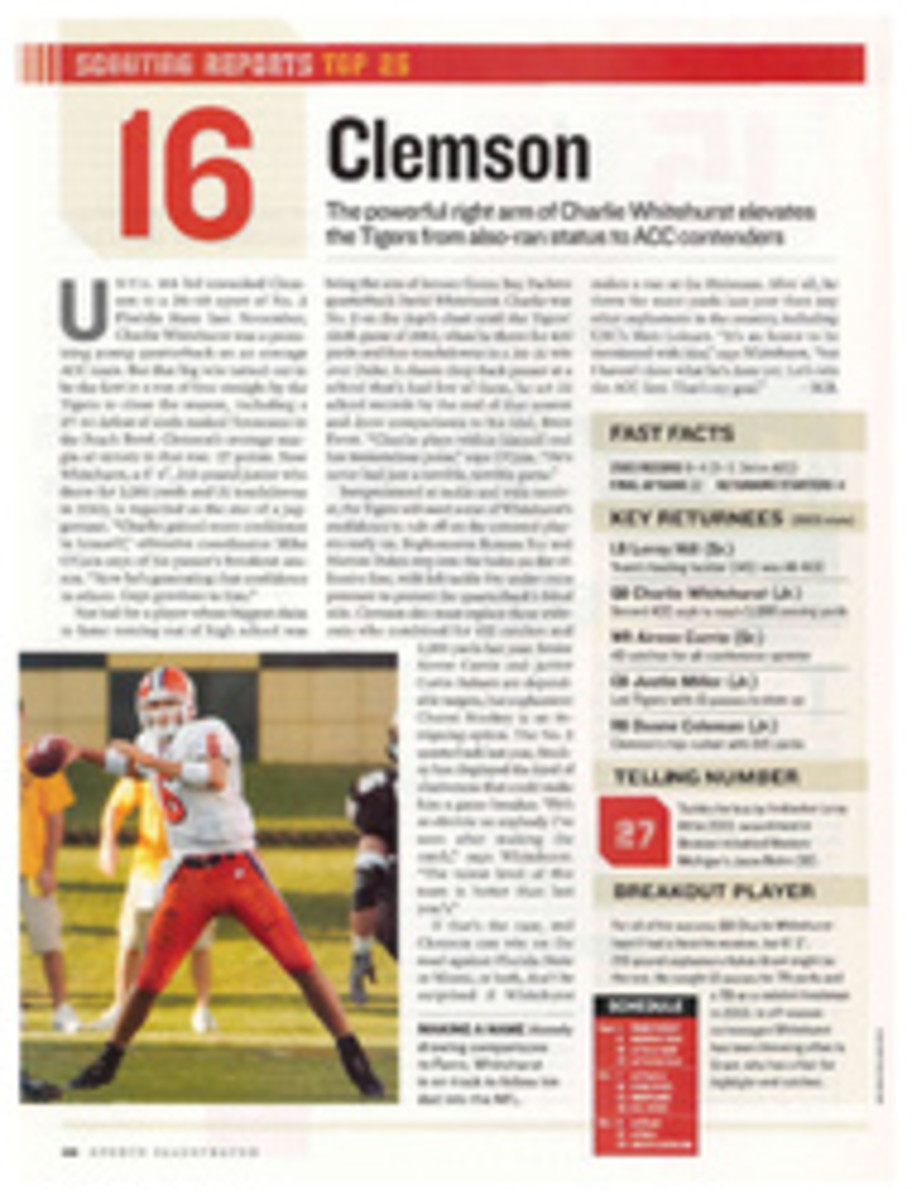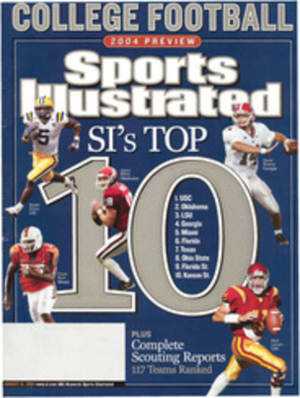
The Big Switch
Never mind that he hadn’t seen the kid make a tackle. During a recruiting stop in May 2002 coach Nick Saban quickly concluded that 17-year-old LaRon Landry could become LSU’s next great defensive player. The 6'2", 185-pound junior was a starting quarterback and part-time defensive back for 5A power Hahnville High, in Boutte, La. After watching Landry run through some offensive drills, Saban pulled him aside, gestured toward Hahnville’s speediest receiver and asked, “Could you cover that guy?” * Landry didn’t miss a beat. “Cover him?” the player responded. “I’d kill him.” Saban, satisfied, soon offered him a scholarship. * As a senior the following fall, Landry threw for 1,639 yards and 16 touchdowns for the 11–2 Hahnville Tigers. The next season he had a team-leading 80 tackles as a freshman free safety for the co-national-champion LSU Tigers. Reflecting on that day in Boutte recently, Saban leaned back in his office chair and recalled what he had seen. “LaRon had the size, the speed and the competitiveness to be an in-the-box safety with the attitude of a linebacker, or a roving safety with ball skills, which is how we pictured him,” he said. “He could probably even play some wide receiver for us. Truly great players do it all.”
Highly adaptable athletes such as Landry, who are often denoted by the shorthand ATH on recruiting websites and college coaches’ whiteboards, are the hottest commodity in football. Of the 16 ATHs listed among Rivals.com’s top 250 high school prospects on signing day last February, the first four were snapped up by top programs Georgia, Florida, USC and LSU, respectively. “There is no question that we’ve seen more and better players coming out as multiskilled athletes over the past few years, and the schools that are winning with athleticism and speed--the Florida States, the Miamis, the LSUs and the USCs of the world--are going after them,” says Rivals recruiting expert Jeremy Crabtree. “Coaches like Saban rely on their ability to evaluate talent, and then they coach these big, fast, strong guys into position players.”
The concept has been around for years, but until recently it was the rare athlete who could fill the bill. Typically the best athletes on their high school teams, quarterbacks have long been recruited and turned into running backs, wide receivers, defensive backs or even, like Florida sophomore standout Earl Everett, linebackers. (What’s more, for decades after major college programs were integrated, black high school quarterbacks were still discriminated against when they were automatically switched to another skill position.)
Now the concept has spread throughout the lineup. High school tight ends are bulking up to fill holes on the interior line--or on the defensive line--in college. That was the case with LSU’s Marcus Spears, who developed into an All-SEC defensive end as a junior last year, and Miami’s Eric Winston, who became an All–Big East tackle as a junior in 2003. “We’re thinking of creating a new category just called Linemen,” says Allen Wallace, publisher of SuperPrep magazine, which also rates blue-chip prospects, “because you just don’t know [at what positions] some of these guys are going to land.”
Another phase in the emergence of the ATH was the reappearance of the two-way player. Cornerback Deion Sanders’s experience as a part-time receiver in the NFL paved the way for college DB-WRs such as Heisman Trophy winner Charles Woodson of Michigan, All-America Champ Bailey of Georgia and All-America Chris Gamble of Ohio State.
Why are more players so easily able to change positions? The most obvious answer is that today’s blue-chippers are better conditioned than ever. “High school kids all over the field are eating better and training better than they did even five years ago,” says recruiting analyst Tom Lemming. “They go to college in shape and ready to contribute, and coaches want to get them on the field one way or another.”
LSU is a prime example: Of the 22 starters for the Tigers’ young Sugar Bowl team last January, nine had played different positions in high school. “A decade ago, having these players was considered a luxury,” says Wallace. “Now colleges consider them a necessity.”
Scholarship limits also compelled coaches to start looking for more versatile athletes. In the ’90s the NCAA dropped that limit from 95 per team to 85. That put pressure on programs to find imaginative ways to ration scholarships, and all-purpose athletes offer more bang for the buck. “If they’re talented enough, you’ll find a spot for them, and often it’s like you’re signing two players,” says Miami coach Larry Coker, who estimates that a third of his recruits have wound up in a different position from the one they were projected to play. “You have to make sure you have a signing class that has at least five guys who are versatile players. It gives you flexibility.”
And, by extension, a means to be more creative with a game plan. “There is less of a discrepancy between good and bad teams, and coaches talk about being pressed to become more creative in order to win,” says Wallace. “Athletes who can catch, run, throw and hit allow you to make use of things like trick plays.”
To execute his multiple offensive and defensive schemes, Saban is constantly on the lookout for players with the tools to contribute immediately. “One reason there are more ‘athletes’ factoring into our system is because the game is changing,” says Saban. “Nobody used to play four wideouts. Nobody used to play empty--no backs in the backfield. We use both of those sets and many more.”
In a single game, Saban says, there are about two dozen distinct offensive roles that require players with specific body types and skill sets. When he visits as many as six schools in a day in the speed-rich Southeast, Saban looks past a prospect’s statistics and focuses on how the youngster’s height, weight, basic abilities and growth potential match up with carefully thought-out ideals for offensive and defensive roles. It’s a process Saban learned from coach Bill Belichick, for whom he served as the Cleveland Browns’ defensive coordinator in the early 1990s and who has stocked his Super Bowl–champion New England Patriots with versatile role players. “We couldn’t care less what our guys played in high school,” says LSU assistant head coach Derek Dooley, who also directs special teams and running backs. “We’ll move them all until we find a fit.”
Spring practice was, as usual, a position carousel for Saban’s players. Reserve tailback Joseph Addai (a quarterback in high school), strong safety Ronnie Prude and cornerback Corey Webster all worked out at wide receiver. Senior corner Travis Daniels played strong safety and free safety as well as corner in four-man, nickel and dime situations. Meanwhile, various tackles, guards and centers were scooted up and down the line. Says Dooley, “I think we all have ADD from all of the switching going on.”
Though he’s joking, Dooley does raise an important question: How does all this shuffling affect the players? After all, the more versatile the athlete, the more inclined a coach will be to use him to fill a new hole. Multiple position changes limit a young player’s development at any one spot.
Consider Louisville sophomore Michael Bush, a consensus top five “athlete” during the 2003 recruiting season. At Louisville’s Male High, Bush played six positions over his first three seasons but spent his senior year exclusively at quarterback and was named Kentucky’s Mr. Football. He signed with the Cardinals expecting to remain a passer, but the surprise success of starter Stefan LeFors last year limited Bush to spot duty under center. Instead, he saw most of his time at running back (81 carries for 503 yards) and wideout (17 catches for 240 yards). With LeFors back for his senior year and highly rated quarterback recruit Brian Brohm arriving this summer, Bush has been asked to work out at running back and safety in preparation for this fall.
“Whereas other guys can concentrate on one thing in drills, the whistle blows and I have to run as far as 60 yards across the field to switch groups and switch modes,” says Bush, who nevertheless feels lucky that his skills allow him to escape the glut at his preferred position. “You’ve got to make the best of what you can do and think about the next level.”
Most players with NFL aspirations understand that they’re better off being anywhere on the field than on the bench. And coaches can sell the idea of a position change by pointing to recent success stories, such as those of two high picks in the draft last spring. As a redshirt freshman at Iowa in 2000, tight end Robert Gallery had three catches for 52 yards in his first four games before being switched to tackle for the Hawkeyes’ Big Ten opener; he went on to win the 2003 Outland Trophy and become the No. 2 pick in the draft, by the Oakland Raiders. At Miami, Sean Taylor went from a lightly recruited running back to the nation’s best free safety and was drafted fifth, by the Washington Redskins.
New converts include Clemson’s Tye Hill, who as a sophomore last year switched from reserve running back to starting cornerback partly because he was having difficulty adding weight to his 180-pound frame. “I have a chance to play for the [NFL] now,” he says. “Everything I wanted to do in college I’m doing now. It’s just that I didn’t think I would be doing it at cornerback.”
That feeling is echoed by Corey Webster, LaRon Landry’s teammate in the LSU secondary and arguably the best pure athlete in college football. Long before he became an All-America cornerback, Webster won 32 of 40 games as a three-year starting quarterback at St. James (La.) High. After he was moved to wideout by Saban and caught seven passes for 74 yards as a freshman in 2001, Webster was approached by the coach about playing defense. “My response was, ‘Nah, don’t think so,’” Webster says. “I hated the idea.” But when Saban broached the subject again midway through the ’02 season--going so far as to suggest that Webster could become an All-SEC defensive back if he were to make the leap--Webster warmed to the idea. “I made a couple plays at cornerback in practice and started feeling comfortable,” says Webster, who’ll play a little wide receiver this fall. “A year later I was all-conference. It proves that Coach knows what he’s doing.”
What switcheroos does Saban have in store for this season? He’s keeping his wild cards close to the vest, but don’t be shocked to see old and new faces--including freshman athletes Early Doucet and Lavelle Hawkins--in surprising places. Asked his thoughts on his coach’s suggestion that he might chip in at wideout if needed, Landry laughs. “I’ve got enough to worry about with making defensive calls at safety this year,” he says. But after a pause Landry admits he “wouldn’t mind catching a few passes.”
Saban wouldn’t have his players thinking any other way. ■
Of the 22 starters for the Tigers in the Sugar Bowl, nine had played different positions in high school.
Most players with NFL aspirations know they’re better off anywhere on the field than on the bench.
COLOR PHOTO
COLOR PHOTO
Photograph by Michael J. Lebrecht II/1deuce3 photography
Five movers and shakers for the Tigers (from left). Joseph Addai High school: QB College: RB Marcus Spears High school: TE College: DE Corey Webster High school: QB College: CB LaRon Landry High school: QB College: FS Ronnie Prude High school: QB College: CB
B/W PHOTO
STUDENTSPORTS.COM
END TO END
Spears went from high school pass catcher to college QB smasher.
COLOR PHOTO
BOB ROSATO
 See caption above. 
B/W PHOTO
ALEX BRANDON/THE TIMES-PICAYUNE
ATHLETE IN ACTION
The multiskilled Landry easily made the shift from offense to defense.
COLOR PHOTO
STEVE FRANZ/LSU SPORTS INFORMATION/ICON SMI
 See caption above. 

